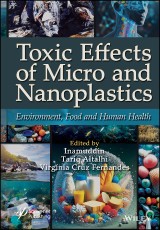Details
Toxic Effects of Micro- and Nanoplastics
Environment, Food and Human Health1. Aufl.
|
216,99 € |
|
| Verlag: | Wiley |
| Format: | |
| Veröffentl.: | 23.05.2024 |
| ISBN/EAN: | 9781394238149 |
| Sprache: | englisch |
| Anzahl Seiten: | 608 |
DRM-geschütztes eBook, Sie benötigen z.B. Adobe Digital Editions und eine Adobe ID zum Lesen.
Beschreibungen
<p><b>This book provides in-depth coverage of the sources, dispersion, life cycle assessment strategies, physico-chemical interactions, methods of analysis, toxicological investigation, and remediation strategies of micro and nanoplastics.</b> <p>Micro and nanoplastics are the degradation products of large plastic compounds. These degraded polymers enter into the natural environment, including air, water, and food, which leads to various significant threats to human health. The nature of these micro and nanoplastics is persistent and consequently accumulates in the exposed person’s body. Research into microplastics has shown that these particles accumulate in various human organs and impart detrimental effects on humans. To safeguard human health, analysis and remediation strategies are necessary. This book provides a comprehensive overview in 24 chapters on the source, distribution, life cycle assessment strategies, physico-chemical interactions, methods of analysis, toxicological investigation, and remediation strategies of micro and nanoplastics. <p><b>Audience</b> <p>This book is a valuable resource for chemists and polymer scientists in various industries including plastics, fisheries, food and beverages, environmental sciences, agriculture, and medicine, as well as government policymakers.
<p><b>Inamuddin, PhD, </b> is an assistant professor at the Department of Applied Chemistry, Zakir Husain College of Engineering and Technology, Faculty of Engineering and Technology, Aligarh Muslim University, Aligarh, India. He has extensive research experience in the multidisciplinary fields of analytical chemistry, materials chemistry, electrochemistry, renewable energy, and environmental science. He has worked on different research projects funded by various government agencies and universities and is the recipient of awards, including the Department of Science and Technology, India, Fast-Track Young Scientist Award, and Young Researcher of the Year Award 2020 from Aligarh Muslim University. He has published about 210 research articles in various international scientific journals, 18 book chapters, and 170 edited books with multiple well-known publishers. His current research interests include ion exchange materials, sensors for heavy metal ions, biofuel cells, supercapacitors, and bending actuators. <p><b>Tariq Altalhi, PhD, </b> is Head of the Department of Chemistry and Vice Dean of the Science College at Taif University, Saudi Arabia. He received his PhD from the University of Adelaide, Australia in 2014. His research interests include developing advanced chemistry-based solutions for solid and liquid municipal waste management and converting plastic bags to carbon nanotubes and fly ash to efficient adsorbent material. He also researches natural extracts and their application in generating value-added products such as nanomaterials. <p><b>Virgínia Cruz Fernandes, PhD, </b> is a professor in the Department of Chemical Engineering, Institute of Engineering of Porto, Polytechnic of Porto, Portugal. She obtained a Ph.D. in chemistry from the University of Porto in 2012. Her interests include toxicology, human health, and nutrition. Her research addresses the analytical process and data processing using analytics techniques. She has published 50 publications in international peer journals, eight book chapters, and received 11 awards.
<p><b>This book provides in-depth coverage of the sources, dispersion, life cycle assessment strategies, physico-chemical interactions, methods of analysis, toxicological investigation, and remediation strategies of micro and nanoplastics.</b> <p>Micro and nanoplastics are the degradation products of large plastic compounds. These degraded polymers enter into the natural environment, including air, water, and food, which leads to various significant threats to human health. The nature of these micro and nanoplastics is persistent and consequently accumulates in the exposed person’s body. Research into microplastics has shown that these particles accumulate in various human organs and impart detrimental effects on humans. To safeguard human health, analysis and remediation strategies are necessary. This book provides a comprehensive overview in 24 chapters on the source, distribution, life cycle assessment strategies, physico-chemical interactions, methods of analysis, toxicological investigation, and remediation strategies of micro and nanoplastics. <p><b>Audience</b> <p>This book is a valuable resource for chemists and polymer scientists in various industries including plastics, fisheries, food and beverages, environmental sciences, agriculture, and medicine, as well as government policymakers.


















